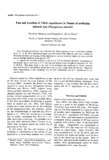Fate and location of Vibrio anguillarum in tissues of artificially infected ayu (Plecoglossus altivelis)
Share
Abstract
Ayu (Plecoglossus altivelis) were infected with Vibrio anguillarum by a water-born method. At 6, 12, 18, 36, 38-45 (moribund stage) and 48 h (dead) after infection, fish were sampled to determine the fate and location of the bacterium in various tissues by viable cell count and the enzyme-labeled antibody technique (ELAT). V. anguillarum was first detected in the skin at 12 h by bacterial isolation. It appeared in the muscle, spleen and liver at 24 h, but was not isolated from the gills or intestine until 36 h or 38-45 h. The same trend in the fate of the pathogen was confirmed by ELAT, and the cells were found in dermal layer of the skin from the early stage (12h) of infection. Based on these observations it was concluded that the first colonization site of V. anguillarum in ayu was the skin.
Suggested Citation
Muroga, K., & de La Cruz, M. C. (1987). Fate and location of Vibrio anguillarum in tissues of artificially infected ayu (Plecoglossus altivelis). Fish Pathology , 22(2), 99-103. https://doi.org/10.3147/jsfp.22.99
Subject
Collections
- AQD Journal Articles [1248]

